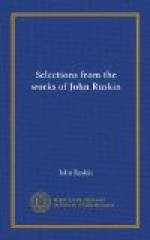These marked variations were, however, only permitted as part of the great system of perpetual change which ran through every member of Gothic design, and rendered it as endless a field for the beholder’s inquiry as for the builder’s imagination: change, which in the best schools is subtle and delicate, and rendered more delightful by intermingling of a noble monotony; in the more barbaric schools is somewhat fantastic and redundant; but, in all, a necessary and constant condition of the life of the school. Sometimes the variety is in one feature, sometimes in another; it may be in the capitals or crockets, in the niches or the traceries, or in all together, but in some one or other of the features it will be found always. If the mouldings are constant, the surface sculpture will change; if the capitals are of a fixed design, the traceries will change; if the traceries are monotonous, the capitals will change; and if even, as in some fine schools, the early English for example, there is the slightest approximation to an unvarying type of mouldings, capitals, and floral decoration, the variety is found in the disposition of the masses, and in the figure sculpture.
I must now refer for a moment, before we quit the consideration of this, the second mental element of Gothic, to the opening of the third chapter of the Seven Lamps of Architecture, in which the distinction was drawn (Sec. 2) between man gathering and man governing; between his acceptance of the sources of delight from nature, and his development of authoritative or imaginative power in their arrangement: for the two mental elements, not only of Gothic, but of all good architecture, which we have just been examining, belong to it, and are admirable in it, chiefly as it is, more than any other subject of art, the work of man, and the expression of the average power of man. A picture or poem is often little more than a feeble utterance of man’s admiration of something out of himself; but architecture approaches more to a creation of his own, born of his necessities, and expressive of his nature. It is also, in some sort, the work of the whole race, while the picture or statue are the work of one only, in most cases more highly gifted than his fellows. And therefore we may expect that the first two elements of good architecture should be expressive of some great truths commonly belonging to the whole race, and necessary to be understood or felt by them in all their work that they do under the sun. And observe what they are: the confession of Imperfection, and the confession of Desire of Change. The building of the bird and the bee needs not express anything like this. It is perfect and unchanging. But just because we are something better than birds or bees, our building must confess that we have not reached the perfection we can imagine, and cannot rest in the condition we have attained. If we pretend to have reached either perfection or satisfaction, we have degraded ourselves and our work. God’s




